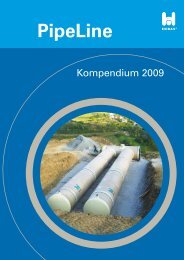PipeLine - Hobas Pipes
PipeLine - Hobas Pipes
PipeLine - Hobas Pipes
Create successful ePaper yourself
Turn your PDF publications into a flip-book with our unique Google optimized e-Paper software.
h <strong>PipeLine</strong> | Compendium 2009 | Page 11<br />
All Show and All Substance in Tilburg, NL<br />
Efficient Relining with h NC Line ®<br />
Wins No Dig Award<br />
The sewer in Sint Josephstraat, The Netherlands, is part of the Tilburg<br />
main sewer and is an important link in the system of the waste water<br />
treatment plant and the rainwater overflow at the Wilhelmina Channel.<br />
Designed in 1927 and installed one year later, it consists of a concrete<br />
base with a masonry arch. Its transversal section is that of a reversed<br />
egg profile, with 1.90 m maximal width and 2.15 m height.<br />
In the late 90’s the road above the sewer constantly subsided. Inspection<br />
with radar equipment showed that this problem occurred due<br />
to the collapse of cavities beside the sewer. The cavities themselves<br />
developed because of sand being washed through<br />
cracks in the base of the construction. Repair works became<br />
immanent and resin was injected to stop the sand<br />
from passing through. This solution, however, proved to<br />
be unsuccessful so that the municipality of Tilburg was<br />
confronted with the question whether to take structural<br />
measures.<br />
The problem was solved step by step and with the<br />
support of external consultancies and also HOBAS<br />
Benelux offered their expertise.<br />
Step 1 - Research<br />
To find the cause for the cracks in the sewer, drill<br />
samples were taken from the line. Each sample was<br />
strength tested. The masonry proved to be of excellent<br />
quality: strength > 60 N/m 2. The quality of the concrete<br />
base, however, did not exceed class B10 and calculations<br />
proved that the cracks evolved due to an overload on the<br />
structure.<br />
Step 2 - Evaluation<br />
The gravity and scope of damage had to be evaluated in order<br />
to determine which measures were to be taken and what<br />
should be prioritized. Sewer renovations ask for tailor-made<br />
solutions where local circumstances play an important role.<br />
Since repairs did not solve the problem, relining or the<br />
replacement of the sewer had to be taken into consideration.<br />
The latter option would have called for the destruction<br />
of the complete existing line in open trench whereas<br />
with relining the old structure would remain. The idea of<br />
replacing the sewer was soon set aside for it posed technical<br />
as well as implementation problems. Moreover it would<br />
have been the most costly method.<br />
Basing the decision on the analysis, Tilburg chose prefabricated<br />
reinforced plastic (GRP) pipe elements to reline the whole<br />
affected section. An important precondition concerning pipe<br />
capacity was the maximal acceptable diameter reduction of 10 cm.<br />
This limited the number of sliplining methods (“lining with continuous”<br />
or “discrete pipes”). Another criterion was the length of the damaged<br />
section which does not except horizontal deviations (angle distortion)<br />
in the line.



